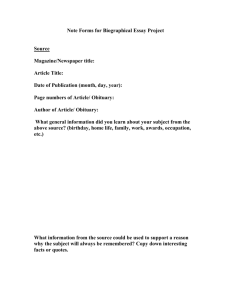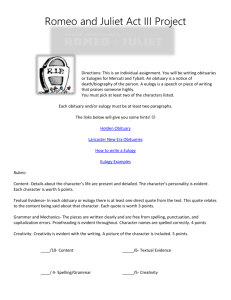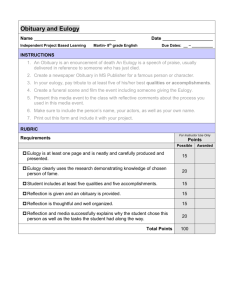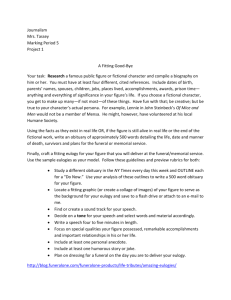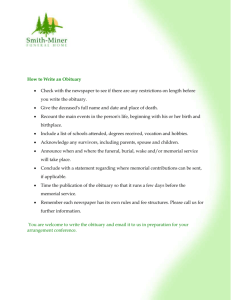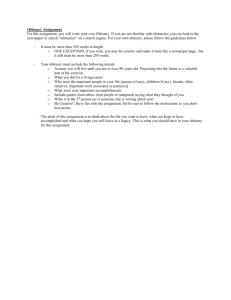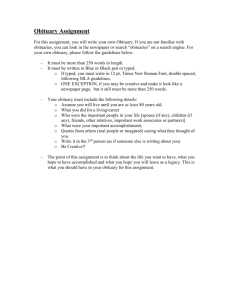To Kill A Mockingbird Analysis
advertisement
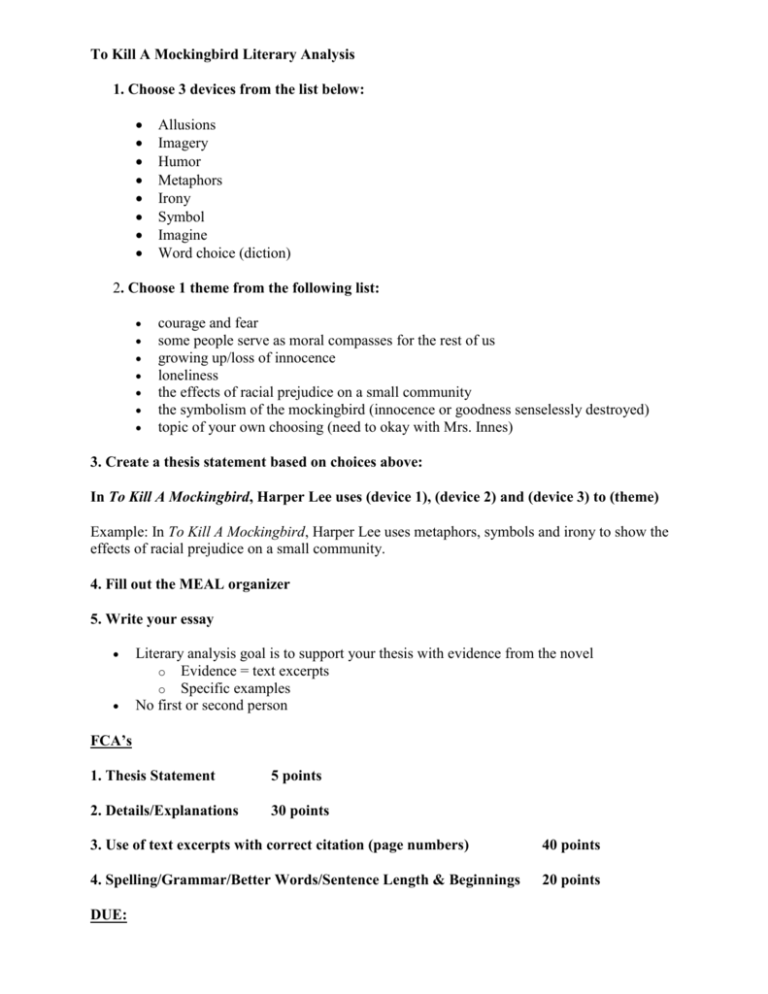
To Kill A Mockingbird Literary Analysis 1. Choose 3 devices from the list below: Allusions Imagery Humor Metaphors Irony Symbol Imagine Word choice (diction) 2. Choose 1 theme from the following list: courage and fear some people serve as moral compasses for the rest of us growing up/loss of innocence loneliness the effects of racial prejudice on a small community the symbolism of the mockingbird (innocence or goodness senselessly destroyed) topic of your own choosing (need to okay with Mrs. Innes) 3. Create a thesis statement based on choices above: In To Kill A Mockingbird, Harper Lee uses (device 1), (device 2) and (device 3) to (theme) Example: In To Kill A Mockingbird, Harper Lee uses metaphors, symbols and irony to show the effects of racial prejudice on a small community. 4. Fill out the MEAL organizer 5. Write your essay Literary analysis goal is to support your thesis with evidence from the novel o Evidence = text excerpts o Specific examples No first or second person FCA’s 1. Thesis Statement 5 points 2. Details/Explanations 30 points 3. Use of text excerpts with correct citation (page numbers) 40 points 4. Spelling/Grammar/Better Words/Sentence Length & Beginnings 20 points DUE: Final Project Choices: 1. 2. 3. 4. A character study of one of the main characters. A letter from one character to another. A newspaper article. A poem for two voices using two of the characters in the novel, or one character and something else. 5. Another kind of poem. 6. An obituary or a eulogy. 7. A comic strip (8 panes) that illustrates a major event from the novel. Use a comic strip from a Sunday newspaper as an example of how to set up the title, the drawings and the character's voices. 8. A monologue from one of the main characters that reveals his or her feelings about an event from the novel. 9. A speech. 10. A recipe. 11. A fictionalized journal entry (from the perspective of one of the characters). 12. Something else? You suggest an idea to your teacher. Character Study Choose one of the main characters and using words, paint a word portrait of him or her. Write about any of the following: interests, relationships with other characters, personality, problems that face him or her, and or anything else that you think will help your reader understand that character better. To help you get the information you need, first fill out a chart like the one that follows. A character study is written in third person; you are the author who knows everything about the character. Think about sentence fluency as you write. Read your character study aloud to make sure it reads smoothly and that it sounds good. What does this character look like? How old is he/she? What is his/her name? Give examples of this character's speech/words. Give examples of this character's thoughts. Give examples of this character's actions. How do other characters view this characters? What does this character do for fun or for personal interest? What would this character want if he/she could have anything in the world? What are the relationships to other characters that this character has? Letter Choose one character from column A below and write a letter from him or her to the character you choose from column B below. The letter should be written as a personal letter and should include all the important details you think that person would include in a letter. To help you decide what to write about, ask yourself what person A has to say and why. Also, why did you choose person B to get the letter. In other words, the relationship you create between these two characters will help you know just what to write in the letter. What does the one have to say to the other? A B Scout Atticus Jem Tom Robinson Dill Mrs. Dubose Atticus Arthur Radley Arthur Radley Scout Miss Maudie Calpurnia Calpurnia Mayella Ewell Choose your own pair Obituary/Eulogy An obituary is a newspaper account of a person's death and life. It generally includes the main events of his or her life, the person's family, and any special accomplishments from his or her life. If the person's death was "famous," there might be details of the circumstances. The audience for the obituary is the general public. A eulogy is similar to an obituary, but it is a speech instead of an article. A eulogy is given by someone who knew the person well or by someone in his or her family. The eulogy is generally more personal and the audience is all the people in attendance at the funeral or memorial service. In writing either, the main purpose is to honor the life of someone who has died. Monologue A monologue is a part in a play or dramatic narrative where one character is talking alone. What he or she says represents his inner thoughts and feelings. He or she may not have an audience other than the reader or the theatre audience. In other words, the other characters in the play or narrative do not usually hear the words of the speaker. When you write this monologue, choice of character is very important. Decide what he or she is thinking inside. What is he/she feeling? What would he/she tell the world if it would listen? Also, set the scene. Before the monologue, in a short paragraph, tell who the speaker is, where he/she is (set the scene visually), and tell what has happened in the life of this character so far (very briefly: like "this is after such and such" or "before the blank happens." If you just write from the character's heart, you will probably know what you want to say. News Article A good news article answers the basic questions: who, what, when, where, why and how. It also uses direct quotes from people who were there and witnessed an event or who know something about the event. A good reporter will report both or all sides of the story. Use a real news story as your model for writing this story. Create a headline for the story also. For this assignment, focus on one event from the novel, such as the trial or Bob Ewell's harrassment of the children. To get more examples, read the stories on the front pages of newspapers to get the sound and structure of a common news story. (News is on the front page. Other types of articles are found elsewhere in the newspaper).
